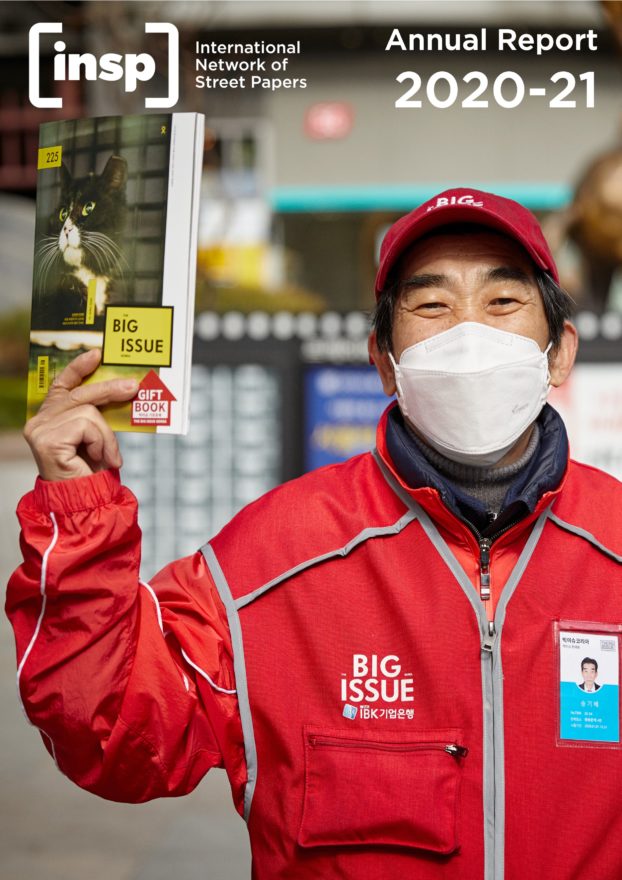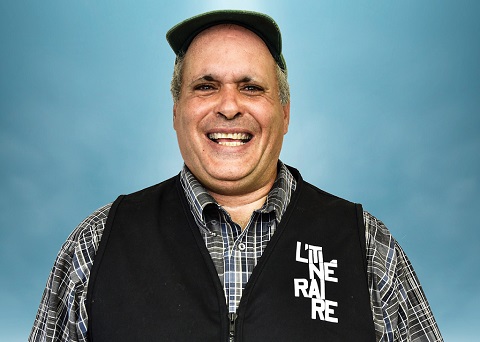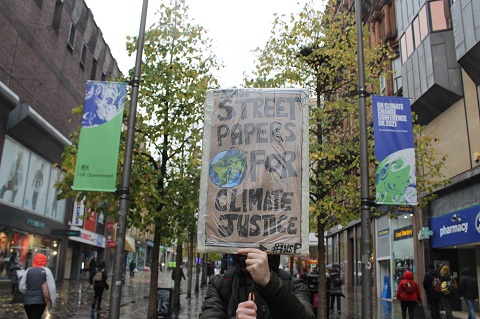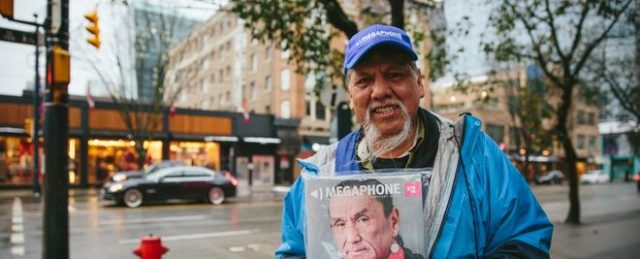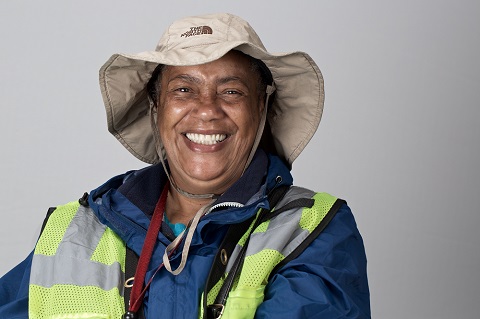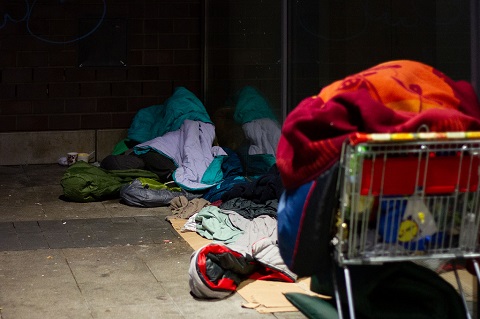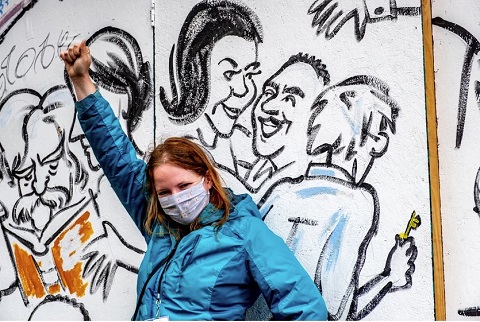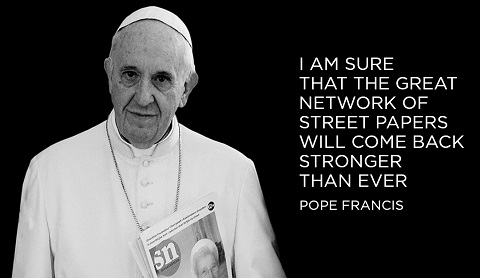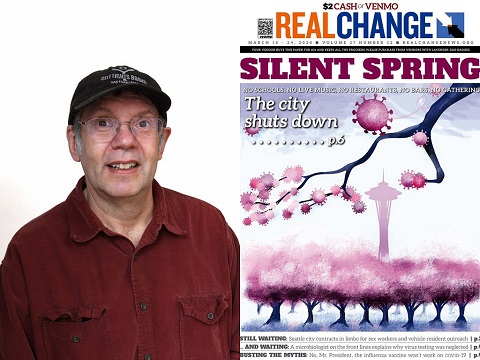For a quarter of a century, INSP has supported street papers to promote independent media and quality journalism that provide a source of income and support to people experiencing poverty from its base in Glasgow.
Throughout 2019, INSP has been celebrating this milestone by showcasing the global impact and reach of the street paper movement and, as the last few months of the year approach, is hoping to draw attention even further to its work, and that of its members.
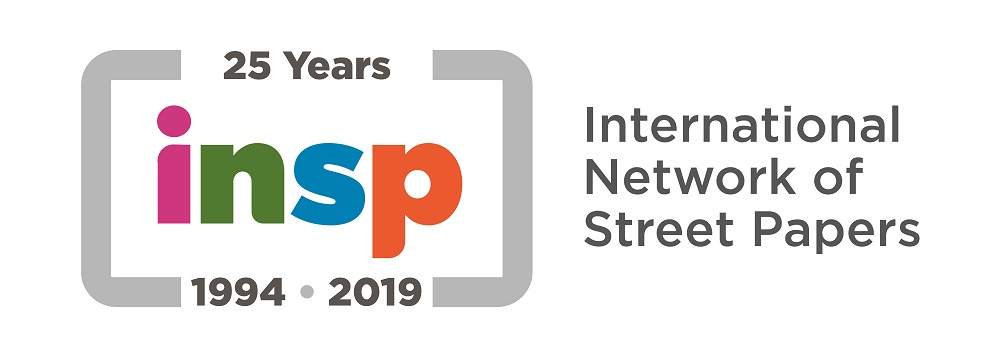
Speaking about the anniversary, INSP’s chief executive Maree Aldam said: “For 25 years, INSP has supported the street paper movement to help tens of thousands of homeless vendors each year to earn an income and improve their lives.
“During this time, we have seen social shifts and economic changes that pose challenges to our street papers but also mean that their work – supporting some of the most marginalised people in our towns and cities – has never been more important.”
As of this year, over 100 street papers make up INSP’s network of members, scattered across 35 countries, and printed in 25 languages. This year alone has seen new members added to the cohort, including the first ever street paper in Peru. It’s a sign that, even though a rapidly changing world continues to throw obstacles in the way, street papers are surviving – in many cases thriving – and INSP remains there to support them and their vendors, who, as individuals, continue to come up against socio-political factors, discrimination, criminalisation, stigmatisation, and even violence, in their fight to earn an income, take shelter, obtain permanent housing and pull themselves out of poverty.
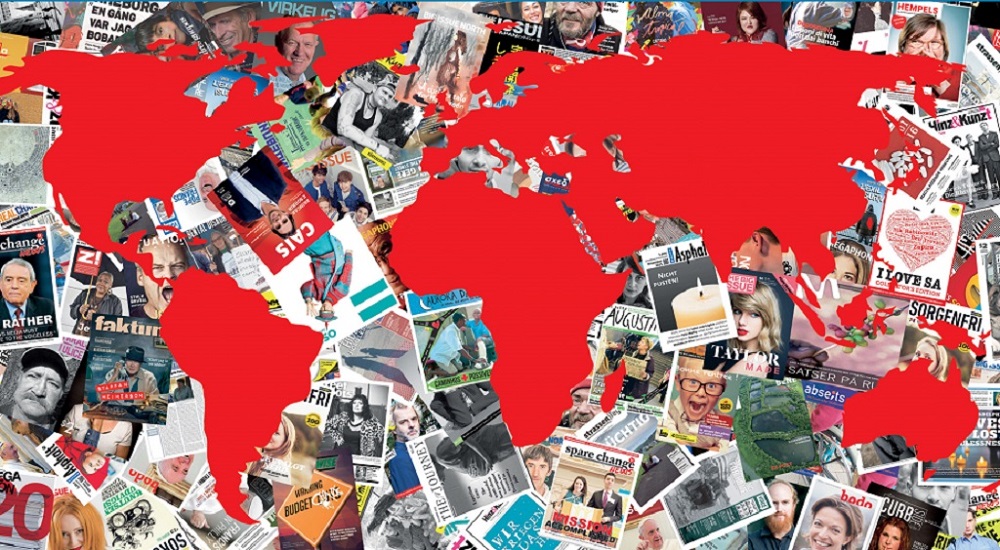
She added: “In recent years, the global recession and related political and economic changes have had a significant impact on urban poverty and homelessness, with issues such as economic migration, unemployment and housing shortages increasing the need for innovative solutions like street papers. Digital developments in media consumption and cashless payments are a challenge to street papers but with our support, street paper organisations are evolving and innovating.
“Throughout our 25th anniversary year, and in the years ahead, we will support our street papers to stay relevant in a changing world. We will continue to provide editorial content, business development support and training to our street papers, and we will also increasingly support our network to collaborate at different levels – locally, regionally and internationally – exploring new ways to innovate and increase the social impact of street papers.”

INSP’s 25th birthday celebrations kicked off in February with its annual #VendorWeek, honouring the individuals at the very centre of the movement. The 2019 instalment of the Global Street Paper Summit – always a highlight of the network’s calendar – saw important faces, old and new, from throughout the history of the network meet, talk and get to the centre of the issues street papers face today and the innovations taking them forward. INSP’s first ever chair and co-founder Mel Young spoke to current chair Fay Selvan about their experiences, and fielded questions about how times have changed, while delegates were given opportunities to quiz, critique and reminisce the movement as a whole. In the Summit’s host city of Hannover, awards were dished out, recognising the best of the street paper network. Not least was the inclusion of a special award chosen by the public (the first ever) for their favourite cover, with the eventual winner being Kralji Ulice of Slovenia.
![(L-R) Fay Selvan, Hannele Huhtala and Mel Young at the 2019 Global Street Paper Summit in Hannover. [Credit: Sebastian Sellhorst]](https://hub.insp.ngo/wp-content/uploads/2019/09/INSP_25th-anniversary_8.jpg)
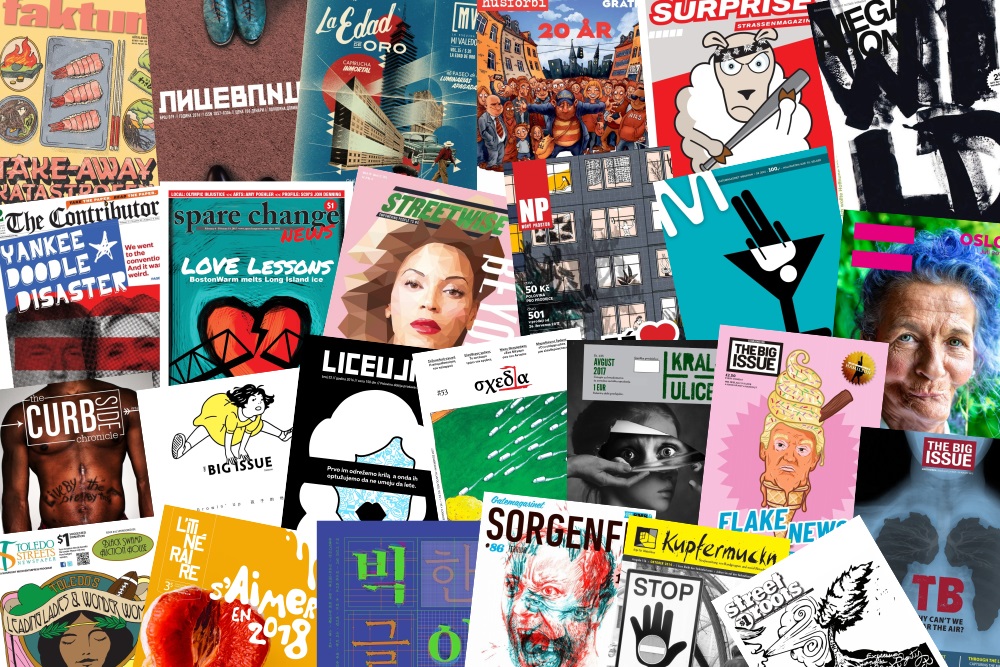
![Kralji Ulice editor-in-chief Jean Nikolic accepts the People's Cover Award at the 2019 INSP Awards. [Credit: Selim Korycki]](https://hub.insp.ngo/wp-content/uploads/2019/09/INSP_25th-anniversary_10.jpg)
New content has come to the INSP News Service, the network’s news wire for street papers, in the form of a partnership with non-profit news organisation Next City; the seeds for greater regional support and collaboration were sown thanks to mini-summits and the establishment of INSP North America; work has been done to get to the root of calculating how valuable INSP membership is through a consultancy project with Edinburgh-based student-led organisation FreshSight; readers have gone round the world with vendors as their guide, sat in the stands at an international sporting tournament for the homeless community and much more.
To take celebrations even further, in September, INSP is sharing statistics gathered from its annual survey – the only one of its kind to measure the impact of street papers. In the last year, street papers have put £24.2 million in the pockets of vendors worldwide.
And as a way of displaying to the world this impact, INSP is taking part in the inaugural Edinburgh International Magazine Festival, including Magfest (20 September) where INSP board member Nikoleta Kosovac, of Serbian street paper Liceulice, will take part in a panel discussion, chaired by Big Issue editor Paul McNamee, talking about the ways magazines can shape our society, spark conversations and shift perceptions.
![Delegates populate an interactive timeline spanning INSP's 25 years. [Credit: Sebastian Sellhorst]](https://hub.insp.ngo/wp-content/uploads/2019/09/INSP_25th-anniversary_11.jpg)
A shared anniversary
As well as being a landmark year for INSP, 2019 sees a number of street paper members celebrate 25th birthdays, many of which spoke to INSP about their longevity and continuing inspirational work.
25 years is a long time in the world of journalism and publishing, but it is particularly special for those working in street papers. Many of those interviewed commented on the changing media landscape. The majority both praised and bemoaned their existence, and in a sense both are valid. Street papers are doing extraordinarily well to continue, and be successful, in an environment where print journalism is less popular, funding opportunities are less accessible and other external factors – political, social, cultural – impact their vendors, and for that they should be proud. At the same time, street papers exist because homelessness exists, as it did 25 years ago, and that’s not something to be satisfied with.
“Our biggest achievement is that we still exist,” says Volker Macke, editor-in-chief of Hannover’s Asphalt, which celebrated its 25th anniversary with a special edition of the street paper and a party with supporters, readers and vendors in the city, as it hosted the 2019 Global Street Paper Summit, in June. “That our little street paper could help all in all about 3,000 formerly homeless or poor vendors throughout the past 25 years – that’s something we’re proud of.”
![Asphalt's birthday gala in Hannover during the week of the 2019 Global Street Paper Summit. [Credit: Selim Korycki]](https://hub.insp.ngo/wp-content/uploads/2019/09/INSP_25th-anniversary_9.jpg)
It’s true still that, as street papers grow, there is a tinge of sadness. Of course, growth shows that these organisations are helping more people, but often it can also be a reflection of an increase in need as well as success. After all, the ultimate success is the eradication of homelessness and poverty.
“At the beginning, we had maybe 30 to 40 vendors; now it’s more than 80. This is a change, not a success. It tells us that there are more poor people,” says Ilse Weiss, editor of street paper Strassenkreuzer, which started out with a print run of 10,000 every three months when it was established in 1994, but now prints 18,000 on a monthly basis.
Very modern phenomena, like the refugee crisis, have also contributed to the scale of the issue in countries like Germany. Weiss adds: “More people are homeless now [there are an estimated 1,200 homeless people living in Strassenkreuzer’s base city of Nuremberg, according to Weiss], and many more poor people from other European countries come to German towns with some hope of an income and a future. But they mostly fail in the streets. There are thousands of refugees who do not have an easy future here. The gap is deeper now between those with and those without money and resources.”
While those papers celebrating 25 years in the movement are wildly geographically different, there was wide consensus that, despite the great strides they have made as individual organisations to fill the gaps, homelessness is not decreasing drastically enough.
![Asphalt vendor Reghina. [Credit: Svea Kohl]](https://hub.insp.ngo/wp-content/uploads/2019/09/INSP_25th-anniversary_12.jpg)
“The homeless people on Hannover’s streets are no longer as visible as in the Nineties because we have more shelters today,” says Macke. “But they are still there, still poor, and, due to a new housing shortage in the last five to ten years, still without homes. Formerly homeless people who now live in shelters have no chance to get their own flat or other permanent accommodation. They stand at the end of a long queue.”
Put Domoi is a street paper in Russia, probably one of the most hostile and authoritarian environments of all those who are a part of the network. Its editor-in-chief Arkady Tiurin describes similar trends in homelessness as those by Macke, though is a little more philosophical: “External [visible] homelessness decreased markedly, whole internal [hidden] homelessness remained at the same level. However, it has always been with humanity.”
In other places, small wins are frustratingly counteracted. In Utrecht, numbers of 1,500 rough sleepers were lowered thanks to easily accessible shelters and healthcare around the mid-2000s, but is rising again due to insufficient social housing and care for young homeless people, according to Frank Dries, editor-in-chief of the area’s street paper, Straatnieuws. There was a similar reaction by Sylvia Rizvi, editor-in-chief of Trott-war: “The safety net for the homeless community has improved. There’s now a lot of specialist counselling services, integration projects, aid organisations and non-permanent assisted living facilities. Accommodation for the homeless is now often significantly better than before.
“Though, for organisations that want to help, it is difficult to find anywhere for their clients. Here in Württemberg, where Trott-war is on sale, there is far too little affordable accommodation. There are also too few council properties and even fewer year on year.”
The availability, and quality, of accommodation is even more drastic in Göttingen. “Durable accommodation is getting more and more impossible and a lot of working poor people here are facing homelessness today,” says Tagessatz editor Ute Kahle. “The social housing market here is facing a breakdown and a lot of people with work will be homeless soon, not being able to pay rising housing costs. ‘Shelter [conditions] are worse than jail’ is a quote from one of our vendors from last year – no words need to be added there.”
![Trott-war vendor Peter Bröckel. [Courtesy of Trott-war]](https://hub.insp.ngo/wp-content/uploads/2019/09/INSP_25th-anniversary_13.jpg)
In a detailed response, L’Itinéraire’s executive director Luc Desjardins outlined how homelessness in the street paper’s city of Montréal is disproportionately affecting women, the indigenous population (less than one per cent of the general population is indigenous, and yet the community makes up more than 12 per cent of homeless people in the city) and the elderly (the number of elderly homeless people there has quadrupled in the last 20 years).
In Seattle, it’s an influx of the middle and upper classes, as opposed to refugees, that has had a detrimental effect on homelessness. “Since we started, Seattle has become tied with San Francisco for most unequal city in America and rates of homelessness have more than tripled,” says Real Change founding director, and INSP board member, Tim Harris. “We are a national leader in both housing first and the tiny houses movement, but the economic dislocation caused by gentrification and state level disinvestment in mental health and drug and alcohol treatment have accelerated the rate of homelessness.”
This anecdotal evidence may be cause for concern, but interviewees also highlighted the expansion of street papers to meet the challenge of supporting the ever-increasing number of those who could use their assistance. One of the main ways is their development in to larger scale organisations providing training opportunities, extra-curricular activities, other innovative ways for homeless people and vendors to earn an income, and engaging in political activism, something that has changed radically in 25 years.
“[When L’Itinéraire came into existence in 1994] the public was wary of these homeless people selling their paper on the street. But thanks to partnerships with the city, transit authorities, the media and, of course, the vendors themselves, L’Itinéraire became a part of the Montréal landscape,” explains Desjardins, whose street paper celebrated its anniversary with a bumper special edition, participation in the World Press Photo exhibition and a big sell event, where 25 notable local name paired with vendors to sell the magazine for a day (12 September), raising in excess of $30,000.
![L'Itinéraire were featured as part of the 2019 World Press Photo Expo in Montréal. [Image courtesy of L'Itinéraire]](https://hub.insp.ngo/wp-content/uploads/2019/09/INSP_25th-anniversary_6.jpg)
Real Change, which hosts its annual breakfast on 19 September, which will act as a celebration of its achievement of 25 years, has grown to create a lasting impact on its community. “In 2010, we ran an initiative campaign that helped change the conversation on poverty crime in Seattle and stopped construction of a new municipal jail for misdemeanants,” says Harris of one of Real Change’s biggest achievements. “Seattle is now a national leader in diversion-based approaches to low level arrests involving mental illness and drug use, and this was a pivotal moment in that evolution.”
And Portugal’s CAIS, another street paper reaching its 25th birthday, sees its scope as much larger. “After CAIS was founded, the great impact it had on people’s lives was visible, especially in their self-esteem and dignity. Given the social and economic changes in Portugal over time, what started as a street paper quickly became a bigger organisation with broader and more specific answers to people with different needs,” explains its executive director Conceição Cordeiro. “CAIS was able to extend its response in multiple areas, offering social and employment support, training and raising awareness about entrepreneurship and social responsibility.”
![CAIS vendor António Pia. [Photo courtesy of CAIS]](https://hub.insp.ngo/wp-content/uploads/2019/09/INSP_25th-anniversary_15.jpg)
For some of those spoken to, there are hyper-specific things. A regular writing workshop for vendors and social city tours at Strassenkreuzer; bringing vendors more integrally into the creation of the publication at L’Itinéraire, which even produces an annual 100 per cent vendor issue, as well as ensuring a path into possible employment in the media industry thanks to internships and mentoring for those vendors; an art project at Trott-war which works with established artists to create a gallery space for socially disadvantaged artists to make an income from their creativity; and in the Netherlands, a consolidation of three of the country’s seven street papers, including Straatnieuws, pooling resources so as to ensure survival and “have a bigger impact nationwide”, resulting in shared pages in each of their revamped publications.
There is a sense that street papers are about even more than what they originally started out as. Straatnieuws’ Dries puts it most succinctly: “First of all we have helped countless numbers of people to earn an honest income. Secondly, but by a smaller margin, we gave them a voice, a face and made them visible on the street.”
![Real Change Founding Director Tim Harris (right) sells copies of Real Change alongside vendor Darryl Manassa (left) for vendor week during Feb. 2018. [Photo by Sam Holman]](https://hub.insp.ngo/wp-content/uploads/2019/09/INSP_25th-anniversary_14.jpg)
With 25 years under the belt, and many other INSP members across the network set to celebrate equally impressive achievements in years to come, these now veteran street papers can now look to the future. Some have messages of support for INSP and fellow street papers, while others want to share their hopes and aspirations.
“I don’t have big hopes; I prefer small ones anyway. But I dream: I would appreciate more honest discussions in politics and society about equity and chances. Less money thinking, and more democracy. I dream of Housing First possibilities for at least some homeless people. And that we sell out every month,” says Weiss with a wink.
Harris is more realistic: “Our biggest challenges are to be part of the active resistance to social exclusion and growing inequality, and to adapt to the new media landscape by bridging print and digital media. [Street papers] all learn from each other and are stronger when we work together.”
Tiurin is again gnomic, but inspirational: “We don’t dictate what other people should do. But we are an example of living without illusions and fear.”
And, of course, there are straightforward proclamations of thanks and solidarity.
“We would like to congratulate the work done by the street paper network over these 25 years,” says Cordeiro. “We would like for that good job to continue, to fight social exclusion and poverty until this is no longer necessary. Innovation, new solutions, good practices and exchange between different partners in different countries are needed to keep improving and adapting to changes that might come.”
![Vendor Jean-Claude (left) taking part in L'Itinéraire's "Camelot d'un Jour" event. [Photo by Alexandre Duguay]](https://hub.insp.ngo/wp-content/uploads/2019/09/INSP_25th-anniversary_5.jpg)
Similarly, Desjardins adds: “L’Itinéraire has been fighting the good fight alongside INSP. We are proud to be part of the worldwide street paper movement, one that offers concrete solutions for getting people off the streets, empowering them, helping them regain self-esteem and allowing them a dignified way to earn an income. Thanks to INSP, our stories – and those of all the street papers in the world – gain a larger audience, and create a greater public awareness of the homeless situation.”
Common amongst all the sentiments is Rizvi’s final declaration: “Together we are stronger.”
Translation assistance by Louise Thomas




